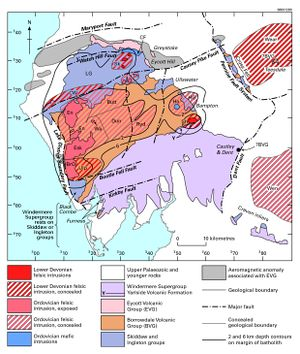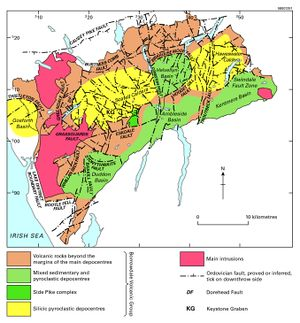Borrowdale Volcanic Group, introduction, Caradoc magmatism, Ordovician, Northern England
From: Stone, P, Millward, D, Young, B, Merritt, J W, Clarke, S M, McCormac, M and Lawrence, D J D. 2010. British regional geology: Northern England. Fifth edition. Keyworth, Nottingham: British Geological Survey.
Introduction




Borrowdale volcanic rocks form the craggy mountains of the central Lake District, but also crop out in the Cross Fell, Teesdale and Furness inliers (P916043). In west Cumbria, a substantial thickness of mainly pyroclastic rocks has been proved in deep boreholes underlying Upper Palaeozoic rocks.
The subaerial Borrowdale volcanic sequence is stratigraphically complex with more than one hundred formations and members designated. These variations record the evolving patterns of volcanism, and thus the development of the volcanic field and its associated depocentres (P916046). The principal development phases and the active depocentres are listed in (P916111), and the distribution of the successions shown in (P916047). In the following account only the few most important of the units are referred to by name.
The group can be divided informally into ‘lower’ and ‘upper’ parts, representing two contrasting eruptive phases: an early one, mainly of andesite lavas, formed a field of low-profile volcanoes, whereas a later, dominantly silicic phase featured voluminous eruptions of pyroclastic density currents and resulted in caldera formation. In this account, the term ‘pyroclastic density current’ is used to encompass the spectrum of gravity-driven pyroclastic currents that includes pyroclastic surges and pyroclastic flows as its end members.
The fundamental change in eruption style recognised at the base of the upper part of the group saw the probably contemporaneous emplacement of stratified caldera successions at Scafell and Haweswater (P916111), phases 4a, b; (P916045). The topographical depression created at Scafell was then infilled with the fluvial and lacustrine volcaniclastic sediments that form the top of the succession there. The products of ensuing eruptions accumulated in fault-controlled depocentres developed along a trend parallel to, and south of, these calderas. The Duddon (phase 5a) and Kentmere (phase 5b) basins developed contemporaneously in the south-west and eastern parts of the Lake District respectively. Subsequently, the Ambleside depocentre became active (phase 6).
Then followed the Lincomb Tarns Formation, the most voluminous ignimbrite preserved within the Borrowdale Volcanic Group (phase 7). Volcaniclastic sedimentation once again dominated in the ensuing Helvellyn succession (phase 8). The major, largely concealed, pyroclastic succession in west Cumbria is probably caldera related (phase 9a). However, the relationship of the West Cumbria volcanic rocks with other Borrowdale volcanic successions is unknown, as is that of the succession in the Cross Fell Inlier (phase 9b); either may contain some of the youngest volcanic deposits.
The later successions contain thick sequences of stratified volcaniclastic rocks and these host abundant contemporaneous sills. Contrasting styles of clastic sedimentation are recorded by these sequences. Episodes of diminished eruptive activity are characterised by units containing abundant fluvial channels and their deposits, and by laminated mudstone and siltstone that accumulated in a lacustrine setting. By contrast, huge volumes of unstable sediment were mobilised almost instantaneously during large-magnitude pyroclastic eruptions or by collapse of existing unlithified materials as a result of seismicity, and then transported by mass-flow processes to form lithologically uniform sheet-like deposits.
Bibliography
Beddoe-Stephens, B, Petterson, M G, Millward, D, and Marriner, G F. 1995. Geochemical variation and magmatic cyclicity within an Ordovician continental-arc volcanic field: the lower Borrowdale Volcanic Group, English Lake District. Journal of Volcanology and Geothermal Research, Vol. 65, 81–110.
Branney, M J, and Kokelaar, B P. 1994. Volcanotectonic faulting, soft-state deformation and rheomorphism of tuffs during development of a piecemeal caldera, English Lake District. Geological Society of America Bulletin, Vol. 106, 507–530.
Branney, M J, and Soper, N J. 1988. Ordovician volcano-tectonics in the English Lake District. Journal of the Geological Society of London, Vol. 145, 367–376.
Branney, M J, and Suthren, R J. 1988. High-level peperitic sills in the English Lake District: distinction from block lavas and implications for Borrowdale Volcanic Group stratigraphy. Geological Journal, Vol. 23, 171–187.
Fitton, J G. 1972. The genetic significance of almandine-pyrope phenocrysts in the calcalkaline Borrowdale Volcanic Group, northern England. Contributions to Mineralogy and Petrology, Vol. 36, 231–248.
Hughes, R A, Evans, J A, Noble, S R, and Rundle, C C. 1996. U-Pb chronology of the Ennerdale and Eskdale intrusions supports subvolcanic relationships with the Borrowdale Volcanic Group (Ordovician, English Lake District). Journal of the Geological Society of London, Vol. 153, 33–38.
Johnson, E W, Briggs, D E G, Suthren, R J, Wright, J L, and Tunnicliff, S P. 1994. Non-marine arthropod traces from the subaerial Ordovician Borrowdale Volcanic Group, English Lake District. Geological Magazine, Vol. 131, 395–406.
Millward, D. 2002. Early Palaeozoic magmatism in the English Lake District. Proceedings of the Yorkshire Geological Society, Vol. 54, 65–93.
Millward, D. 2004. The Caradoc volcanoes of the English Lake District. Proceedings of the Yorkshire Geological Society, Vol. 55, 73–105.
Millward, D, and Evans, J A. 2003. U-Pb chronology and duration of upper Ordovician magmatism in the English Lake District. Journal of the Geological Society of London, Vol. 160, 773–781.
Millward, D, Beddoe-Stephens, B, Williamson, I T, Young, S R, and Petterson, M G. 1994. Lithostratigraphy of a concealed caldera-related ignimbrite sequence within the Borrowdale Volcanic Group of west Cumbria. Proceedings of the Yorkshire Geological Society, Vol. 50, 25–36.
Millward, D, Marriner, G F, and Beddoe-Stephens, B. 2000. The Eycott Volcanic Group, an Ordovician continental-margin andesitic suite in the English Lake District. Proceedings of the Yorkshire Geological Society, Vol. 53, 81–96.
Petterson, M G, Beddoe-Stephens, B, Millward, D, and Johnson, E W. 1992. A pre-caldera plateau-andesite field in the Borrowdale Volcanic Group of the English Lake District. Journal of the Geological Society of London, Vol. 149, 889–906.
Piper, J D A, Stephen, J C, and Branney, M J. 1997. Palaeomagnetism of the Borrowdale and Eycott volcanic groups, English Lake District: primary and secondary magnetisation during a single late Ordovician polarity chron. Geological Magazine, Vol. 134, 481–506.